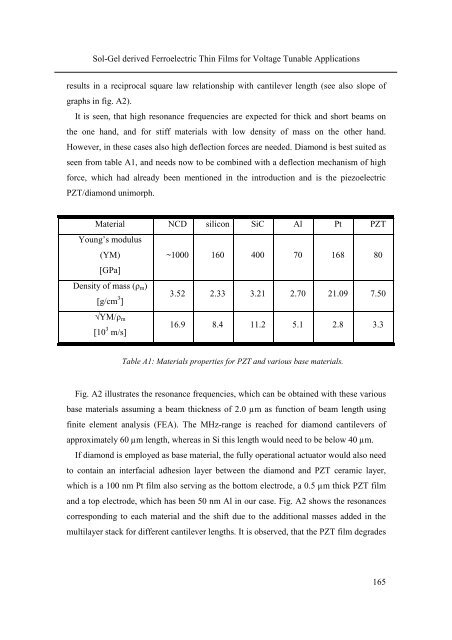PhD Thesis Arne Lüker final version V4 - Cranfield University
PhD Thesis Arne Lüker final version V4 - Cranfield University
PhD Thesis Arne Lüker final version V4 - Cranfield University
You also want an ePaper? Increase the reach of your titles
YUMPU automatically turns print PDFs into web optimized ePapers that Google loves.
Sol-Gel derived Ferroelectric Thin Films for Voltage Tunable Applications<br />
results in a reciprocal square law relationship with cantilever length (see also slope of<br />
graphs in fig. A2).<br />
It is seen, that high resonance frequencies are expected for thick and short beams on<br />
the one hand, and for stiff materials with low density of mass on the other hand.<br />
However, in these cases also high deflection forces are needed. Diamond is best suited as<br />
seen from table A1, and needs now to be combined with a deflection mechanism of high<br />
force, which had already been mentioned in the introduction and is the piezoelectric<br />
PZT/diamond unimorph.<br />
Material NCD silicon SiC Al Pt PZT<br />
Young’s modulus<br />
(YM)<br />
[GPa]<br />
Density of mass (ρm)<br />
[g/cm 3 ]<br />
√YM/ρm<br />
[10 3 m/s]<br />
~1000 160 400 70 168 80<br />
3.52 2.33 3.21 2.70 21.09 7.50<br />
16.9 8.4 11.2 5.1 2.8 3.3<br />
Table A1: Materials properties for PZT and various base materials.<br />
Fig. A2 illustrates the resonance frequencies, which can be obtained with these various<br />
base materials assuming a beam thickness of 2.0 µm as function of beam length using<br />
finite element analysis (FEA). The MHz-range is reached for diamond cantilevers of<br />
approximately 60 µm length, whereas in Si this length would need to be below 40 µm.<br />
If diamond is employed as base material, the fully operational actuator would also need<br />
to contain an interfacial adhesion layer between the diamond and PZT ceramic layer,<br />
which is a 100 nm Pt film also serving as the bottom electrode, a 0.5 µm thick PZT film<br />
and a top electrode, which has been 50 nm Al in our case. Fig. A2 shows the resonances<br />
corresponding to each material and the shift due to the additional masses added in the<br />
multilayer stack for different cantilever lengths. It is observed, that the PZT film degrades<br />
165

















